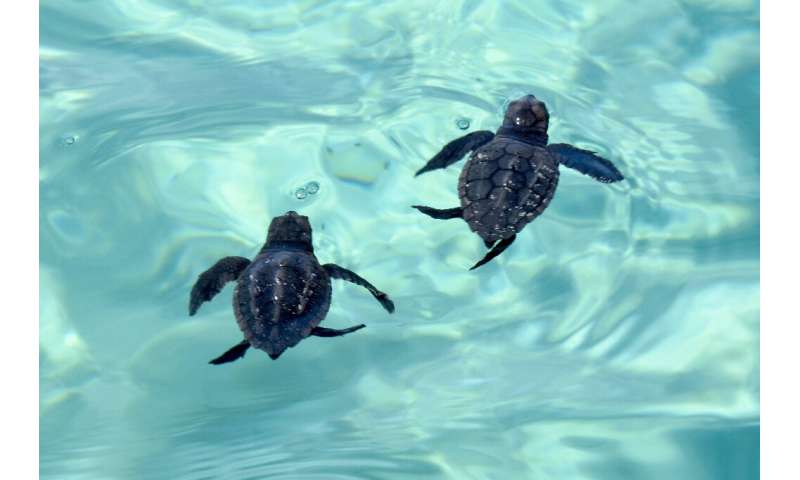
Loggerhead turtle hatchlings head for deeper waters off Tunisia's Kuriat Island
Between plastic chairs on a crowded Tunisian tourist beach, a sign indicates where another species shares the sand: a nest is buried below.
On this paradisaical island off the coast of Monastir—a resort town south of the capital Tunis—tourists co-exist with loggerhead turtles thanks to a novel initiative.
Since 2017, the Tunisian government and a local NGO have jointly run a turtle conservation programme under the noses of bathing-suited beach-goers, who are offered an environmental education along with their holiday.
The Kuriat islands are the westernmost permanent loggerhead turtle breeding site on the Mediterranean's south coast, and are in the process of being listed as a protected nature reserve.
But while the islands are an important turtle sanctuary, the white sand beaches and crystal waters of little Kuriat are irresistible to holidaymakers.
During turtle hatching season from July to October, day-trippers arrive daily in their hundreds, transported on pirate-themed boats for barbecues and swimming.
"I thought that this was just an island where I'd go to swim, eat and return," said holidaymaker Souad Khachnaoui.
"I'd never imagined that this site was so important for turtles, birds and other species."

Beachgoers near a protected turtle nest during the hatching season on Tunisia's Kuriat Island
Rather than ban visitors, the authorities work with local volunteers to brief arriving tourists on the local fauna, including the jellyfish-eating turtles, which can live for a century.
"Many people are stunned on arrival, they didn't think that we had these kinds of animals in our country," said Manel Ben Ismail, co-founder of the environmental NGO Notre Grand Bleu, which means "Our great blue (ocean)".
And if they are lucky, tourists can watch as volunteers help defenceless hatchling turtles—measuring just five centimetres (two inches) across—on their journey from the nest to the sea.
Loggerheads are classified as vulnerable by the International Union for the Conservation of Nature. They do not become fertile until about 20 years old and breed only every two to three years.
Female loggerheads return to the same beach where they were born to lay their clutch of about 100 eggs. But it is a perilous life cycle and only one in a thousand juveniles lives to reproductive age.

Only one in 1,000 of these tiny turtles survives to reproduce at the age of about 20
The Kuriat islands—the largest of which is a military zone and the smaller is not permanently settled—offer young turtles slightly better survival odds.
Both are far from the light pollution of the mainland, which can disorientate hatchlings.
This year 42 nests were recorded on the islands. Layings have increased since monitoring started in 1997.

Go, guys, go... turtle hatchlings are released off Tunisia's Kuriat Island
If managed correctly, tourism can be a boon for the islands as visitors learn about conservation, the government believes.
"We try to strike a balance between ecological activities and the economic activities of people on this site," said Ahmed Ben Hamida, head of the Kuriat Marine Protected Area for the government agency for coastal protection.
Explore further
Sea turtles start nesting season with 'unheard-of' numbers on one NC island, town says
© 2019 AFP
Citation:
Turtles and tourists share the same beach on a Tunisian island (2019, November 27)
retrieved 27 November 2019
from https://phys.org/news/2019-11-turtles-tourists-beach-tunisian-island.html
This document is subject to copyright. Apart from any fair dealing for the purpose of private study or research, no
part may be reproduced without the written permission. The content is provided for information purposes only.
#Biology | https://sciencespies.com/biology/turtles-and-tourists-share-the-same-beach-on-a-tunisian-island/
No comments:
Post a Comment